In anticipation of our upcoming exhibition Dressed in History: A Costume Collection Retrospective, CHM assistant conservator for costume and textiles Julie Benner wrote about the process of conserving a Christian Dior gown for its first time on display.
This stunning Christian Dior gown, called Fidélité, was originally conceived as a wedding dress for Dior’s autumn/winter 1949 collection. It was donated to CHM in 1983 by Ms. Jeanne B. Heinzelman, née Jeanne Brucker. She won the gown from Marshall Field & Co. by raising the most donation money for Passavant Memorial Hospital (now Northwestern Memorial Hospital) and wore it to the 1949 Passavant Cotillion and Christmas Ball.
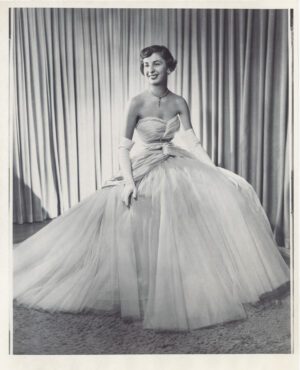
Portrait of Miss Jeanne Brucker in her Dior gown, December 23, 1949. CHM, ICHi-074220
In addition to its unique backstory, another of the gown’s distinctions is its scale: with a skirt diameter of around 6 feet and weighing in at 35 pounds, it is the largest single object to be displayed in Dressed in History. The weight comes from over a hundred yards of fine net (also known as tulle) pleated around the bodice and gathered in voluminous layers throughout the skirt, and nine yards of satin draping that wind around to a fashionable knot in the back of the train.
When the conservation team examined the gown for exhibition, it was clear that we had work to do to ensure its stability for display and revive its signature appeal. After decades of storage, the fabrics were creased, distorted, and exhibited a yellowish cast. We noticed tears, snags, and numerous unstable previous repairs throughout the net, as well as detached fasteners and tacking threads. We set to work documenting its condition, taking measurements for mounting, and developing our treatment plan.
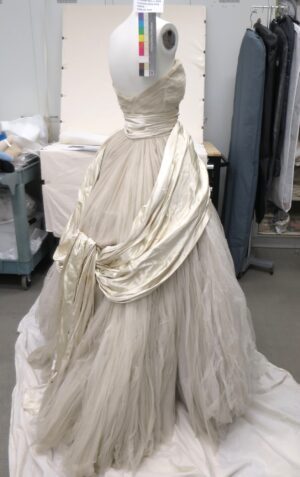
In March 2023, the Dior gown (1983.28.1) underwent a condition assessment before treatment. Note the creasing and distortion of the net skirts and satin drape. Photograph by Julie Benner
We began treatment by surface cleaning the entire exterior and throughout all layers of the skirt to reduce dust accumulation, using a HEPA-filtered variable-speed vacuum on its lowest power setting, further reducing the suction by using a vented hose fitted with micro-attachments.
With the tireless help of conservation volunteer Mia Mehta, we vacuumed systematically through the seemingly unending layers, tracking our work by placing temporary stitches in bright cotton thread to mark our progress, as there was no obvious line between vacuumed and unvacuumed areas.
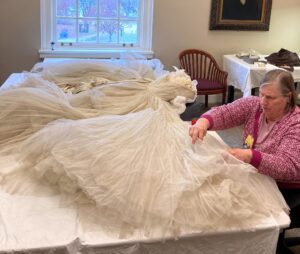
CHM conservation volunteer Mia Mehta methodically vacuumed the layers of net throughout the skirt to reduce dust. Photograph by Julie Benner
The vacuuming process also gave us the opportunity to thoroughly inspect every inch of the net for damages to mark their locations with temporary stitches in another thread color for later repair.
After the surface cleaning, I stabilized areas of damage using a finely loomed nylon bridal net special-ordered from England, securing patches behind holes and tears with silk hair thread. Unstable previous repairs were replaced or modified. Loose fasteners and detached tacking threads in the bodice were re-secured with fine cotton thread.
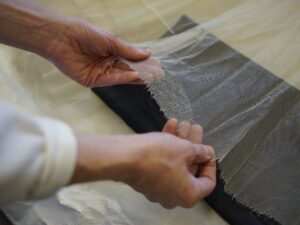
Assistant conservator Julie Benner used insect pins to position a small patch of fine nylon net behind an area of damage in the skirt before securing it in place with silk thread. Photograph by Paulina Budzioch
Once cleaned and stabilized, the most dramatic part of the transformation could now take place. Together, conservation mount maker Michael Hall and I dressed the gown on the mount that he fabricated and customized to the gown’s dimensions. Michael then carefully and painstakingly humidified the skirt layers using a gentle mist of deionized water. The net relaxed readily with his efforts, and the skirts became lofty and luminous.
Now exhibit-ready, the gown embodies a striking contradiction: displaying an abundance of softness and delicacy while commanding attention and unapologetically taking up space.
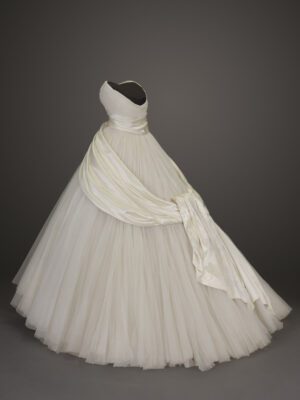
The left oblique view of the Dior gown, 2024. CHM, ICHi-180000
Additional Resources
- Learn more about Dressed in History: A Costume Collection Retrospective, which opens October 19, 2024
- Purchase the Dressed in History: A Costume Collection Retrospective exhibition catalogue
- View images of items in our Costume and Textile Collection
- Visit the Abakanowicz Research Center to peruse our Costume Research Collection